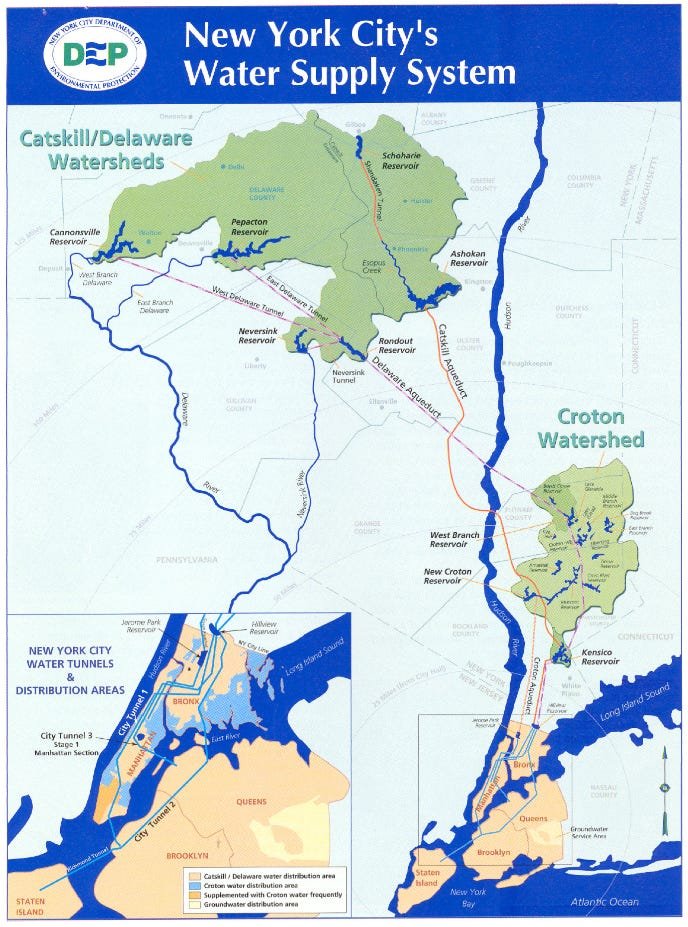The Champagne of H20
by Kathy Zhang, edited by Sonam VelaniYou might not believe it, but water from the NYC watershed is considered to be the “champagne” of drinking water. It consistently wins annual taste tests – we’re not making this stuff up!
As we shared in last week’s Hot Take: Climate Change = Water Change, every single level of government is working behind the scenes to control our water supply. Today, we’re taking a closer look at how water policy plays out in our day to day, and how the acronym soup of government agencies come together to make sure the H2O in your life is just right!
As New York City developed from a small Dutch outpost into a global metropolis, the water system grew with it. A piecemeal patchwork of ponds and streams ultimately became inadequate, especially given water shortages during the Great Fire of 1835. In 1842, the city created its first reservoir with the development of a dam on the Croton River - and there was so much fanfare that we even had parades and fireworks to mark the occasion!
Drink up! A giant party in NYC celebrating the opening of the Croton water system quenching the masses. Source: NYPL Digital Collections
Fast forward to 1974 and the US Safe Drinking Water Act gave the Environmental Protection Agency authority to set national water quality standards and states had the power to set even stricter requirements. The New York State Department of Health, Department of Environmental Conservation, and Public Service Commission came together to govern water quality standards and practices for water suppliers, wastewater treatment facilities, and industrial facilities. They also coordinate with the NYC Department of Environmental Protection (DEP), which operates and maintains an entire system of water bodies and pipes, ensuring it works in clockwork fashion.
Today, 1 billion gallons of water flow through a sprawling network of 3 controlled lakes, 19 reservoirs, and 6,000 miles of aqueducts, tunnels, and pipes all the way to your kitchen sink. The water comes from as far as the Delaware, Catskill, and Croton watersheds, 125 miles up the Hudson River. Combined, the one million acres spread across these watersheds have limited limestone and a natural pH balance of 7.2 - as close as it gets to “pure water” pH balance of 7. This is the stuff that makes it into your pizzas and bagels, and makes our delicacies the envy of the world!
1 billion gallons of water flow through these red and blue lines to your tap EVERY SINGLE DAY! Source: NYC Department of Environmental Protection
Astonishingly, 90% of that water never makes it to a filtration plant – and instead relies on an army of humans and robotic sensors that test the 1.6 million times a year (!) for over 250 contaminants to make sure it’s as clean and safe as ever. The final step is a facility built under the golf course at Van Cortlandt Park that uses UV radiation to kill off any remaining bacteria before it gets to your tap. Our water system is a global model and our friends from Australia, China, India, Singapore, and Colombia regularly visit NYC to learn about this marvel.
This is where your water flows - the inside the Old Croton Aqueduct. Source: NYC Department of Environmental Protection.
So, what’s next? Given the increasing rate of climate disasters and their impact on our infrastructure - from our water supply to our coasts and beyond (more on that next week!) - NYC is making a huge investment in ensuring that the tap never goes dry. The city is building a third water tunnel (cleverly named City Tunnel No. 3…. marketing is not the government’s strong suit!) to increase redundancy in the system. The largest capital project in NYC history, this new tunnel will enable DEP to close City Tunnel No. 1 and City Tunnel No. 2 for repairs, built all the way back in 1917 and 1936, respectively!
Along with these giant infrastructure investments, DEP has also developed a huge educational campaign to help New Yorkers use less water - and it has worked! In 1979, we used 1.5 billion gallons of water per day; today that number is just shy of 1 billion. From low flow faucets, showers, and toilets across NYC’s 1,400 schools to conservation projects across our parks and recreational facilities, millions of gallons of water are saved every year. DEP even works with local universities to reduce water usage on campus and develops programs to spur innovation in blue tech solutions to continue this progress. Demand management projects are in the works and you all are welcome to join the fun.
All to say, the next time someone asks you for a glass of bubbly, you know what to serve them!
by Kathy Zhang, edited by Sonam Velani

